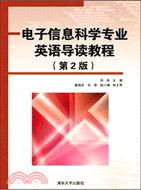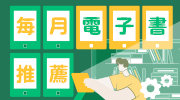電子信息科學專業英語導讀教程(第2版)(簡體書)
商品資訊
ISBN13:9787302288510
出版社:清華大學出版社(大陸)
作者:田嵐; 姜曉慶; 孫蓓; 陸小珊
出版日:2012/07/01
裝訂/頁數:平裝/278頁
商品簡介
名人/編輯推薦
目次
書摘/試閱
相關商品
商品簡介
《電子信息科學專業英語導讀教程(第2版)》圍繞電子信息科學、通信及計算機等前沿領域的相關知識,按知識結構體系組織編排,由淺入深,內容涉及電子信息類專業的電子電路、EDA設計、信號處理與系統開發、計算機網絡、多媒體技術、現代電視技術、移動通信、光纖通信等知識,還包括模式識別與人工智能、DSP技術、嵌入式系統、生物特徵識別、信息安全、GPS、3G通信等熱點內容。書中所選資料突出技術內容的正確性、完整性,並配合適當練習以考察讀者對知識點的掌握。《電子信息科學專業英語導讀教程(第2版)》可使學生熟悉和掌握一定量的專業詞匯和術語,瞭解科技英語寫作和專業交流中的翻譯和寫作技巧,提高閱讀和理解專業英語文獻的能力和速度,培養英語寫作和翻譯技巧,開闊專業視野。
《電子信息科學專業英語導讀教程(第2版)》可作為高等院校電子信息科學、通信工程、計算機科學、自動化技術等相關專業大學本科生專業英語教材,也可作為相關領域專業人員提高英語水平的閱讀參考書。《電子信息科學專業英語導讀教程(第2版)》也適合參加四、六級和研究生入學考試的學生,以便他們熟悉電子信息類學科相關文獻並鍛煉閱讀能力。對於非電子類專業學生,這也是一本補充瞭解IT相關知識的讀物。·
《電子信息科學專業英語導讀教程(第2版)》可作為高等院校電子信息科學、通信工程、計算機科學、自動化技術等相關專業大學本科生專業英語教材,也可作為相關領域專業人員提高英語水平的閱讀參考書。《電子信息科學專業英語導讀教程(第2版)》也適合參加四、六級和研究生入學考試的學生,以便他們熟悉電子信息類學科相關文獻並鍛煉閱讀能力。對於非電子類專業學生,這也是一本補充瞭解IT相關知識的讀物。·
名人/編輯推薦
《電子信息科學專業英語導讀教程(第2版)》可作為高等院校電子信息科學、通信工程、計算機科學、自動化技術等相關專業大學本科生專業英語教材,也可作為相關領域專業人員提高英語水平的閱讀參考書。《電子信息科學專業英語導讀教程(第2版)》也適合參加四、六級和研究生入學考試的學生,以便他們熟悉電子信息類學科相關文獻并鍛煉閱讀能力。對于非電子類專業學生,這也是一本補充了解IT相關知識的讀物。
目次
CONTENTS
Unit 1 Microelectronics and Electronic Circuits
1-1 Introduction to Microelectronics
1-2 How does a logic gate in a microchip work?
1-3 General Electronics Circuits
Reading Material: Nanotechnology-Getting Us Over the Brick Wall
Unit 2 Modern Electronic Design
2-1 Introduction to Configurable Computing
2-2 Cutting Critical Hardware
2-3 The Future of Configurable Computing
Reading Material: FPGAs
Unit 3 Computer Architecture and Microprocessors
3-1 Computer Architecture
3-2 CPU Design Strategies: RISC vs. CISC
3-3 VLIW Microprocessors
Reading Material: Embedded System
Unit 4 Information Network, Protocols and Applications
4-1 Computer Networks
4-2 TCP/IP
4-3 Internet of Things
Reading Material: Technology Roadmap of the IoT
Unit 5 Information Security and Biometrics Technology
5-1 Introduction to Computer Security
5-2 Encryption Methods
5-3 An Overview of Biometrics
Unit 6 Digital Signal Processing and Applications
6-1 Introduction to Digital Signal Processing (DSP)
6-2 Typical DSP Applications
6-3 DSP System Implementation Solution
Unit 7 Speech Signal Processing
7-1 Speech Sampling and Processing
7-2 Speech Coding and Text-to-Speech (TTS) Synthesis
7-3 Speech Recognition and Other Speech Applications
Unit 8 Digital Images Processing
8-1 Representation of Images
8-2 Introduction to Digital Image Processing
8-3 Fingerprint Identification, Hand Geometry and Face Retrial
Reading Material: Digital Image Histogram Adjustment
Unit 9 Modern TV Technology
9-1 Television Video Signals
9-2 Related Technologies
9-3 HDTV
Unit 10 Telecommunication Network
10-1 Introduction to "Communication Systems"
10-2 Satellite Communications
10-3 What is CTI?
Unit 11 Mobile Communications
11-1 The Mobile Telephone System
11-2 3G Mobile Phones: Digital Voice and Data
11-3 Global Positioning System (GPS)
Unit 12 Optical Fiber Communications
12-1 The General Optical Fiber Communication System
12-2 Advantages of Optical Fiber Communication
12-3 Historical Development
Unit 13 Electronic Instrument and Measurement
13-1 Oscilloscopes
13-2 Understanding Waveforms
13-3 Virtual Instruments
Unit 14 Artificial Intelligence Techniques and Applications
14-1 Artificial Intelligence Techniques
14-2 Expert Systems and Robotics
14-3 Development of AI
Unit 15 Pattern Recognition Technology
15-1 Principle of Pattern Recognition
15-2 Exemplary Applications
15-3 Smart Room
附錄1 英文科技論文寫作概要
附錄2 科技英語常用符號及數學公式表達
參考文獻·
Unit 1 Microelectronics and Electronic Circuits
1-1 Introduction to Microelectronics
1-2 How does a logic gate in a microchip work?
1-3 General Electronics Circuits
Reading Material: Nanotechnology-Getting Us Over the Brick Wall
Unit 2 Modern Electronic Design
2-1 Introduction to Configurable Computing
2-2 Cutting Critical Hardware
2-3 The Future of Configurable Computing
Reading Material: FPGAs
Unit 3 Computer Architecture and Microprocessors
3-1 Computer Architecture
3-2 CPU Design Strategies: RISC vs. CISC
3-3 VLIW Microprocessors
Reading Material: Embedded System
Unit 4 Information Network, Protocols and Applications
4-1 Computer Networks
4-2 TCP/IP
4-3 Internet of Things
Reading Material: Technology Roadmap of the IoT
Unit 5 Information Security and Biometrics Technology
5-1 Introduction to Computer Security
5-2 Encryption Methods
5-3 An Overview of Biometrics
Unit 6 Digital Signal Processing and Applications
6-1 Introduction to Digital Signal Processing (DSP)
6-2 Typical DSP Applications
6-3 DSP System Implementation Solution
Unit 7 Speech Signal Processing
7-1 Speech Sampling and Processing
7-2 Speech Coding and Text-to-Speech (TTS) Synthesis
7-3 Speech Recognition and Other Speech Applications
Unit 8 Digital Images Processing
8-1 Representation of Images
8-2 Introduction to Digital Image Processing
8-3 Fingerprint Identification, Hand Geometry and Face Retrial
Reading Material: Digital Image Histogram Adjustment
Unit 9 Modern TV Technology
9-1 Television Video Signals
9-2 Related Technologies
9-3 HDTV
Unit 10 Telecommunication Network
10-1 Introduction to "Communication Systems"
10-2 Satellite Communications
10-3 What is CTI?
Unit 11 Mobile Communications
11-1 The Mobile Telephone System
11-2 3G Mobile Phones: Digital Voice and Data
11-3 Global Positioning System (GPS)
Unit 12 Optical Fiber Communications
12-1 The General Optical Fiber Communication System
12-2 Advantages of Optical Fiber Communication
12-3 Historical Development
Unit 13 Electronic Instrument and Measurement
13-1 Oscilloscopes
13-2 Understanding Waveforms
13-3 Virtual Instruments
Unit 14 Artificial Intelligence Techniques and Applications
14-1 Artificial Intelligence Techniques
14-2 Expert Systems and Robotics
14-3 Development of AI
Unit 15 Pattern Recognition Technology
15-1 Principle of Pattern Recognition
15-2 Exemplary Applications
15-3 Smart Room
附錄1 英文科技論文寫作概要
附錄2 科技英語常用符號及數學公式表達
參考文獻·
書摘/試閱
Unit 2 Modern Electronic Design
2-1 introduction to Configurable Computing
Computers that modify their hardware circuits as they operate are opening a newera in computer design.Because they can filter data rapidly,they excel at patternrecognition,image processing and encryption.
Computer designers face a constant struggle to find the right balance betweenspeed and generality.They can build versatile chips that perform many differentfunctions relatively slowly,or they can devise application-specific chips that do only alimited set of tasks but do them much more quickly.Microprocessors(such as the IntelPentium or Motorola PowerPC chips commonly found in personal computers)aregeneral purpose: programming instructions encoded in binary format can lead amicroprocessor through virtually any logical or mathematical operation a programmercan conceive.[1]The Intel Pentium,for example,was never designed specifically toexecute either Microsoft Word or the computer game DOOM,but it can run both.
I.Configurable Computing
In contrast,custom hardware circuits,of ten known as application-specific integratedcircuits(ASICs),provide precisely the functionality needed for a specific task.Bycarefully tuning each ASIC to a given job,the computer designer can produce a smaller,cheaper,faster chip that consumes less power than a programmable processor.[2]Acustom graphics chip for a PC,for instance,can draw lines or paint pictures on thescreen 10 or 100 times as quickly as a general-purpose central processing unit can.
As designers make their choices between versatility and speed,they must alsoconfront the issue of cost.A well-designed ASIC will solve the specific problem for whichit was designed,but probably not a slightly modified problem introduced after the ASICdesign is finished.Furthermore,even if a modified ASIC can be developed for the newproblem,the original hardware circuits may be too highly customized to be reused insuccessive generations.As a result,the engineering effort required to design and buildan ASIC must be amortized over a relatively small number of units.
主題書展
更多
主題書展
更多書展今日66折
您曾經瀏覽過的商品
購物須知
大陸出版品因裝訂品質及貨運條件與台灣出版品落差甚大,除封面破損、內頁脫落等較嚴重的狀態,其餘商品將正常出貨。
特別提醒:部分書籍附贈之內容(如音頻mp3或影片dvd等)已無實體光碟提供,需以QR CODE 連結至當地網站註冊“並通過驗證程序”,方可下載使用。
無現貨庫存之簡體書,將向海外調貨:
海外有庫存之書籍,等候約45個工作天;
海外無庫存之書籍,平均作業時間約60個工作天,然不保證確定可調到貨,尚請見諒。
為了保護您的權益,「三民網路書店」提供會員七日商品鑑賞期(收到商品為起始日)。
若要辦理退貨,請在商品鑑賞期內寄回,且商品必須是全新狀態與完整包裝(商品、附件、發票、隨貨贈品等)否則恕不接受退貨。
























